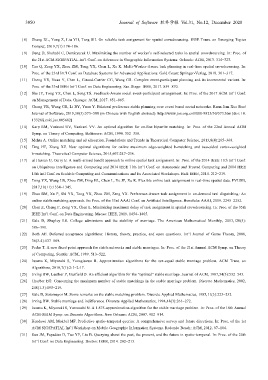Page 184 - 《软件学报》2020年第12期
P. 184
3850 Journal of Software 软件学报 Vol.31, No.12, December 2020
[8] Zhang XL, Yang Z, Liu YH, Tang SH. On reliable task assignment for spatial crowdsourcing. IEEE Trans. on Emerging Topics
Comput, 2019,7(1):174−186.
[9] Deng D, Shahabi C, Demiryurek U. Maximizing the number of worker’s self-selected tasks in spatial crowdsourcing. In: Proc. of
the 21st ACM SIGSPATIAL Int’l Conf. on Advances in Geographic Information Systems. Orlando: ACM, 2013. 314−323.
[10] Tao Q, Zeng YX, Zhou ZM, Tong YX, Chen L, Xu K. Multi-Worker-Aware task planning in real-time spatial crowdsourcing. In:
Proc. of the 23rd Int’l Conf. on Database Systems for Advanced Applications. Gold Coast: Springer-Verlag, 2018. 301−317.
[11] Cheng YR, Yuan Y, Chen L, Giraud-Carrier CG, Wang GR. Complex event-participant planning and its incremental variant. In:
Proc. of the 33rd IEEE Int’l Conf. on Data Engineering. San Diego: IEEE, 2017. 859−870.
[12] She JY, Tong YX, Chen L, Song TS. Feedback-Aware social event-participant arrangement. In: Proc. of the 2017 ACM Int’l Conf.
on Management of Data. Chicago: ACM, 2017. 851−865.
[13] Cheng YR, Wang GR, Li BY, Yuan Y. Bilateral preference stable planning over event based social networks. Ruan Jian Xue Bao/
Journal of Software, 2019,30(3):573−588 (in Chinese with English abstract). http://www.jos.org.cn/1000-9825/30/573.htm [doi: 10.
13328/j.cnki.jos.005682]
[14] Karp RM, Vazirani UV, Vazirani VV. An optimal algorithm for on-line bipartite matching. In: Proc. of the 22nd Annual ACM
Symp. on Theory of Computing. Baltimore: ACM, 1990. 352−358.
[15] Mehta A. Online matching and ad allocation. Foundations and Trends in Theoretical Computer Science, 2013,8(4):265−368.
[16] Ting HF, Xiang XZ. Near optimal algorithms for online maximum edge-weighted b-matching and two-sided vertex-weighted
b-matching. Theoretical Computer Science, 2015,607:247−256.
[17] ul Hassan U, Curry E. A multi-armed bandit approach to online spatial task assignment. In: Proc. of the 2014 IEEE 11th Int’l Conf.
on Ubiquitous Intelligence and Computing and 2014 IEEE 11th Int’l Conf. on Autonomic and Trusted Computing and 2014 IEEE
14th Intl Conf on Scalable Computing and Communications and Its Associated Workshops. Bali: IEEE, 2014. 212−219.
[18] Tong YX, Wang LB, Zhou ZM, Ding BL, Chen L, Ye JP, Xu K. Flexible online task assignment in real-time spatial data. PVLDB,
2017,10(11):1334−1345.
[19] Zhao BM, Xu P, Shi YX, Tong YX, Zhou ZM, Zeng YX. Preference-Aware task assignment in on-demand taxi dispatching: An
online stable matching approach. In: Proc. of the 33rd AAAI Conf. on Artificial Intelligence. Honolulu: AAAI, 2019. 2245−2252.
[20] Chen Z, Cheng P, Zeng YX, Chen L. Minimizing maximum delay of task assignment in spatial crowdsourcing. In: Proc. of the 35th
IEEE Int’l Conf. on Data Engineering. Macao: IEEE, 2019. 1454−1465.
[21] Gale D, Shapley LS. College admissions and the stability of marriage. The American Mathematical Monthly, 2013,120(5):
386−391.
[22] Roth AE. Deferred acceptance algorithms: History, theory, practice, and open questions. Int’l Journal of Game Theory, 2008,
36(3-4):537−569.
[23] Feder T. A new fixed point approach for stable networks and stable marriages. In: Proc. of the 21st Annual ACM Symp. on Theory
of Computing. Seattle: ACM, 1989. 513−522.
[24] Iwama K, Miyazaki S, Yanagisawa H. Approximation algorithms for the sex-equal stable marriage problem. ACM Trans. on
Algorithms, 2010,7(1):2:1−2:17.
[25] Irving RW, Leather P, Gusfield D. An efficient algorithm for the “optimal” stable marriage. Journal of ACM, 1987,34(3):532−543.
[26] Thurber EG. Concerning the maximum number of stable matchings in the stable marriage problem. Discrete Mathematics, 2002,
248(1-3):195−219.
[27] Gale D, Sotomayor M. Some remarks on the stable matching problem. Discrete Applied Mathematics, 1985,11(3):223−232.
[28] Irving RW. Stable marriage and indifference. Discrete Applied Mathematics, 1994,48(3):261−272.
[29] Iwama K, Miyazaki S, Yamauchi N. A 1.875-approximation algorithm for the stable marriage problem. In: Proc. of the 18th Annual
ACM-SIAM Symp. on Discrete Algorithms. New Orleans: ACM, 2007. 902−914.
[30] Hendawi AM, Mokbel MF. Predictive spatio-temporal queries: A comprehensive survey and future directions. In: Proc. of the 1st
ACM SIGSPATIAL Int’l Workshop on Mobile Geographic Information Systems. Redondo Beach: ACM, 2012. 97−104.
[31] Sun JM, Papadias D, Tao YF, Liu B. Querying about the past, the present, and the future in spatio-temporal. In: Proc. of the 20th
Int’l Conf. on Data Engineering. Boston: IEEE, 2014. 202−213.

